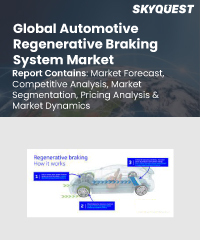
Report ID: SQMIG25A2170

Report ID:
SQMIG25A2170 |
Region:
Global |
Published Date: April, 2024
Pages:
223
|
Tables:
91 |
Figures:
76
Automotive Regenerative Braking System Market size was valued at USD 8.72 Billion in 2023 and is poised to grow from USD 10.07 Billion in 2024 to USD 31.9 Billion by 2032, growing at a CAGR of 15.5% during the forecast period (2025-2032).
The market serves as an essential technology in modifying emissions and conserving fuel within traditional vehicles. This advanced braking system functions as an energy recovery mechanism, adapting the kinetic energy generated during the vehicle's checking into electrical energy.
The bound energy is then deposited in the vehicle's storage unit, powering internal electronics and simplifying various applications. Various energy storage units, including ultra-capacitors and batteries, are working in regenerative braking systems.
The competence of energy recovery, ranging from 5% to 20%, is contingent upon factors like the vehicle's stopping pattern and speed. Moreover, the regenerative braking system is instrumental in generating electricity by taking momentum loss during brake application.
The automotive sector is witnessing sharp demand globally, leading to enlarged vehicle sales and production. Though, this surge in activity has also contributed to escalating greenhouse gas emissions. Governments worldwide are therefore pressuring automakers to adopt advanced technologies that can limit fuel consumption and consume gas emissions.
This has the potential to propel the growth of the Market. The market's expansion is further driven by the rising demand for regenerative braking systems and the growing adoption of these systems, aimed at reducing vehicular emissions and ornamental fuel efficiency.
Anticipated to surpass 75 million by the conclusion of the projected period in 2032, the demand for battery electric vehicle propulsion is poised to meaningfully influence the growth of the regenerative braking systems market. On the supplier front-facing side, there is a distinguished potential for industrial growth in regenerative braking systems, chiefly driven by advancements in technology aimed at enhancing vehicle economy and performance.
The transformation of a vehicle's mechanical energy into electricity, facilitated by regenerative braking motor generators, plays an essential role in spreading battery life and promoting energy recovery in cars. This technological development is expected to be a key driver in fostering the expansion of the market throughout the specified period.
Our industry expert will work with you to provide you with customized data in a short amount of time.
REQUEST FREE CUSTOMIZATIONWant to customize this report? This report can be personalized according to your needs. Our analysts and industry experts will work directly with you to understand your requirements and provide you with customized data in a short amount of time. We offer $1000 worth of FREE customization at the time of purchase.

Report ID: SQMIG25A2170